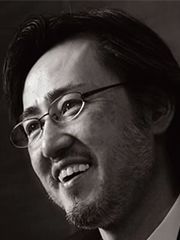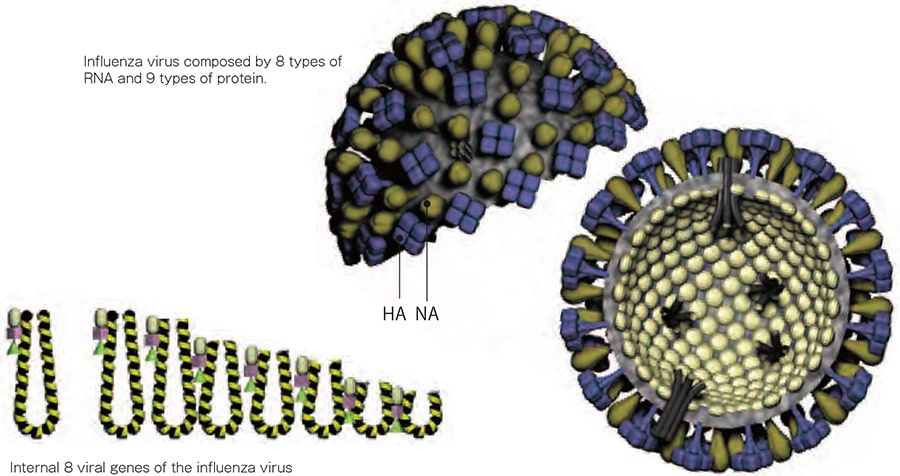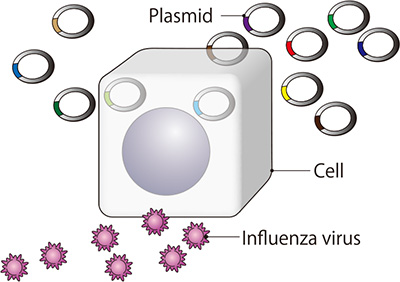Research Results
Developing a groundbreaking artificial synthesis method for the influenza virus
Preventing a new-strain flu pandemic with revolutionary technological capabilities! FY2016

- Yoshihiro Kawaoka (Professor, Division of Virology, Institute of Medical Science, The University of Tokyo)
- CREST
- Translational Research for Intractable Immune Disorders and Infectious Disease
"Understanding the Replication Cycle of Influenza Virus and its Application" Research Director (2001-2007) - ERATO
- "Kawaoka Infection-induced Host Responses Network Project" Research Director (2008-2014)*
*Research expanded from 2009
Putting an end to the fight against the influenza virus
In 2009, a new strain of influenza broke out worldwide and was declared at a Phase 6 state by the World Health Organization (WHO), indicating a pandemic level. This incident is still fresh in our memory. According to data announced by the WHO on February 12, 2012, it caused at least 15,292 confirmed deaths in more than 212 countries and regions worldwide. This incident helped shed some light on why modern medicine, which has come so far in the present day, was helpless against this new-strain influenza.
It is extremely difficult to gain a clear understanding of the characteristics of the influenza virus. Since new viral strains, in particular, can never be fully understood before they actually occur, vaccine development and other efforts always seem to be one step behind. Consequently, many scientists believe that if we were able to artificially synthesize such a virus, vaccines could be deployed immediately after the new strain of influenza emerges, enabling us to prevent pandemics. Research on this subject had been conducted all across the world, but it was Professor Yoshihiro Kawaoka who in 1999 successfully developed the groundbreaking "reverser genetics method" and artificially synthesized an influenza virus. Professor Kawaoka was recognized for this outstanding work in 2006 when he received the most prestigious international medical science award in Germany, the Robert-Koch-Preis, which is awarded each year for outstanding work in fundamental medical research.
Structure of the influenza virus

What does the reverse genetics method?
The research required to protect humanity against new strains of the influenza virus can be divided broadly into three fields. The first is rapid development of new-strain vaccines. The second is research into the mechanisms of infection. The third is research into the causes of death due to the virus. The development of the reverse ge- netics method for artificially synthesizing the virus has spurred a great leap forward in all these areas of essential research, and has given scientists a head start in researching many virus sub-types. In- fluenza research, which was previously always one step behind the vi-rus, has undergone major changes as a result of this new technology.
Artificial synthesis of influenza (conceptual diagram)

Fig. 1
Are people aged 90+ more resistant to new flu?
The new strain of influenza that broke out at worldwide pandemic levels in 2009 had a curious characteristic. While normal seasonal influenza tends to cause more widespread harm to those with less physical resilience such as elderly persons and small children, this new influenza strain spread more among the younger generation, who tend to be healthier and have more physical resilience. Perplexed by this, Professor Kawaoka studied the blood serum of subjects with a diverse range of ages. As a result, he ascertained that many persons aged 90 years or more possessed antibodies for this virus. Why should older people possess antibodies for a supposedly new strain of flu? The question was quickly answered. This "new" strain of influenza was actually antigenically similar as the strain known as the "Spanish flu," which had caused a worldwide flu pandemic over 90 years before, in 1918. Antigenically, many strains of influenza exist; if exposed to a different flu antigen, a person will become infected, even if antibodies are present in their body. Conversely, if a person is infected with influenza once, antibodies will be present in their system and they will have less chance of infection.
In the current case, it is believed that antibodies that had developed 90 years previously in response to the Spanish flu were still functioning effectively in response to the new-strain flu of the same type, even after the passing of 90 years. In short, this was not a flu that was more difficult for elderly people to catch; it was rather that many elderly people already possessed antibodies to this strain of influenza.
This understanding of the mechanisms that govern the emergence of strains of influenza in the past and our establishment of treatment and prevention methods for modern new-strain influenza have been enabled by artificial synthesis of the virus, thanks to the reverse genetics method.
Establishing technology to prevent the emergence of new strains of influenza!
In light of the emergence and worldwide spread of infection of new-strain influenza in 2009, JST expanded its support for Professor Kawaoka's ERATO project. The urgent need was recognized for establishing a solid foundation to provide basic understanding of and prevention/treatment for potential new strains of influenza virus that are likely to emerge in future, using the reverse genetics method: the world's first method of artificial virus synthesis.
The influenza virus keeps changing and evolving inside the human body after infection. The strains of influenza that have greatly troubled the human race in the past— Spanish flu, Asian flu, Hong Kong flu—are likewise caused by its evolution into strongly pathogenic viruses due to changes taking place inside the human body and many iterations of infection. In future, we will seek to understand the pathogenic acquisition mechanisms of the influenza virus, to shed further light upon the infection process, and to ultimately establish technology to prevent the emergence of new-strain influenza virus pandemics
